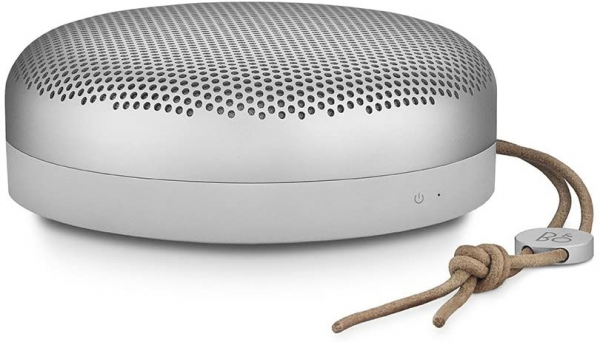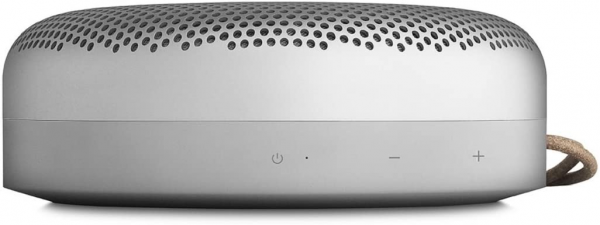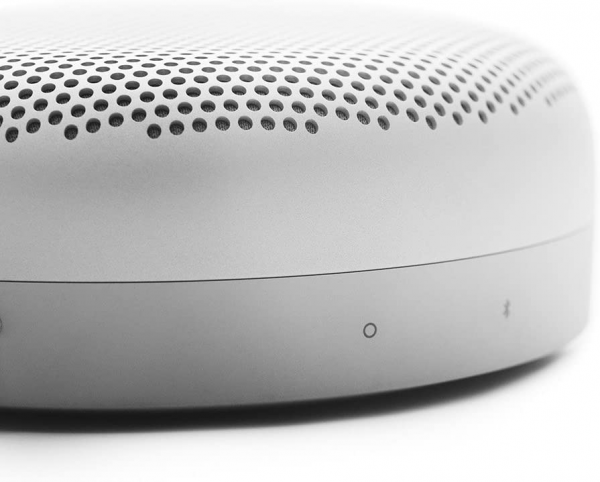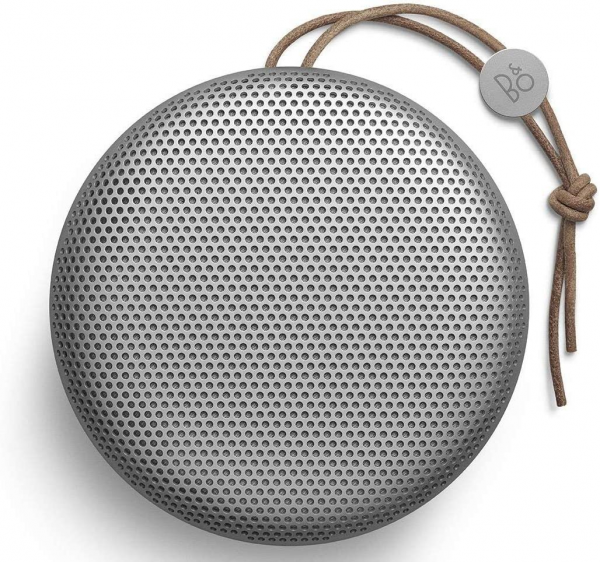B&O Play
B&O Play Beoplay A1: a small speaker that's not cold in the eyes
Aprox. 207€ - see price -
See specificationsAfter the BeoPlay A2, B&O continues its momentum in the world of portable speakers with the A1, a model that puts a lot on its compactness, its look, its autonomy of 24 hours and its response in the bass.
Positive points
Deep and ample bass considering the size of the speaker.
Voice intelligibility.
Very careful manufacturing.
USB-C.
Easy to use.
Bad points
Distortion and heating which prevent the use of the beautiful power reserve of the speaker.
Latency perceptible in Bluetooth.
No navigation between the tracks on the enclosure.
Android application worse off than the iOS version.
Our review
Ergonomics
BeoPlay A1 is in the form of a pebble: the first face consists of an extruded aluminum grid while the second is covered with a softly erased soft-touch plastic. There is little to say about manufacturing; this speaker is solid and benefits from a design and finishes of first order.
The A1 is not designed for extreme conditions, but it can still absorb some splashes and some falls. Even if it is not ultra-compact, it can be easily grasped with one hand, worn or hung thanks to its small leather strap.
Despite its size, this small speaker still has versatile connectors. It can connect wirelessly via Bluetooth 4.2 (aptX compatible), wired via 3.5 mm mini-jack but also USB-C, the latter port not only used to recharge the speaker but also to connect it directly on a PC. It is directly recognized as an audio output; the microphone is recognized as an input device. It is also possible to connect two A1 speakers wirelessly and in stereo.
The integrated controls are quite complete. There is a button for turning on the speaker, a Bluetooth pairing button, a button for playback management, two buttons for volume and a button for call management and voice assistant. As often on the manufacturer's speakers, the sound and light aids are not legion, but they allow you to find your way when you handle the speaker. There are still two points that disappoint us: it is impossible to navigate between the tracks and a significant latency is noticeable when you activate the "pause / play" command, in particular to restart the music after a stop.
The Beoplay application (Android / iOS) comes to the rescue to add some nice functions. The stereo pairing is done through this application, but it also gives access to a simple and intuitive equalization system for neophytes as well as to EQ presets. Unfortunately, the speaker does not keep these settings in memory and therefore depends on the application to take advantage of this customization. In addition, the Android version is less stable, less reactive and the stereo pairing only works after multiple tests.
Regarding autonomy, the manufacturer promises 24 hours of use. In reality, it's a little more complicated. BeoPlay A1 tends to heat up quickly when the volume is increased, above around 60-70%. For safety, the speaker automatically drops to a much lower level, but if we insist a little to listen loudly, the listening time melts like snow in the sun. We then go from the announced 24 hours to only 6 hours. It is possible to go up at 6 pm with a moderate listening volume, already enough to add sound to a room without covering the discussions.
The on-board microphone does the job. It does not need to be extremely close to it to be understood by our interlocutor and it slightly reduces the surrounding noise.

Audio
BeoPlay A1 makes a risky bet by betting a lot on the feeling of impact, depth and immersion in the bass, despite its compactness. It also has a 9 cm woofer and a 20 mm tweeter powered by an amplification of 2 x 30 W RMS. The frequency response would be between 60 Hz and 24 kHz.
BeoPlay A1 is extremely powerful and offers particularly deep and diffuse bass given its size. The result still lacks control when you start listening at a comfortable level (above 60% of the maximum volume). The bass is too full and they take up a lot of space. The impact of each note in this register is very pronounced, leaving behind many masking effects and even pumping effects if you push the speaker to its limits. The very close transients (double bass drum and bearings on large percussions, for example) as well as the rich songs are right with the BeoPlay A1. If we stick to a close listening, this boost is pleasant by adding depth and immersion. It is still a shame not to be able to use the full potential of this speaker.
On the other side of the spectrum, we find treble particularly present and a significant exaggeration of attacks (kick, snare, strings ...). The voices are naturally forward and very intelligible, but the whistling sounds point their nose when one pushes the volume of listening frankly. The small load of distortion around 2/4 kHz excites the harmonics in the treble, which makes for example saturated electric guitars more confused and a little more aggressive at high volume. If by chance the loudspeaker is directed directly towards the listening point - instead of pointing upwards as expected -, the bass loses a little more in amplitude, but we take the brunt of the acidity in the treble.
The EQ of the application does not allow to obtain a more satisfactory result. The Warm zone adds low-mids and accentuates the masking effects while the Relaxed reduces the stage presence without reducing the acidity in the treble. Special mention all the same for the Excited zones (V boost) and Bright (treble boost) which ruin the listening pleasure.
This does not go very well on the side of wireless communication latency. We measured around 225 ms and this is true in practice. The gap is not huge between image and sound, but it is noticeable.

Conclusion
BeoPlay A1 combines ease of use, wide connection possibilities and careful manufacturing. However, it wants to make itself bigger than beef by wanting to offer maximum power and very deep bass despite its size. The result is a pleasant result, but one that lacks control when you want to take advantage of the full power of the speaker.

Specifications
Reviews


Two are definitely better than one!
I've had an old Bose SoundDock Portable for about 10 years now and I've been looking to upgrade it to something smaller but sounded better but was just as loud. That narrowed my list down to the Beoplay A1, JBL Charge 3, and the new Bose Revolve. The JBL was the cheapest on the list and is arguably louder than the A1 and Revolve, but the A1 just sounded so much clearer and the bass, although sounded slightly lower, was more accurate than the Charge 3. The new Bose Revolve just didn ' t match either in sound quality, but it did have better 360 dispersion outdoors and hung. I eliminated the Bose on also having the weakest volume among the 3. So it was between the Charge 3 or the A1. Ultimately, the audio clarity and design won out and I decided on the A1. The Charge 3 isn't that far behind and doubles as a portable phone charger as well but I wasn't too fond of the design and the quality of the bass was less than that of the A1 (boomier but not as tight)
I bought one A1 and I liked it so much I decided to get another one. Took a while to figure out the pairing mode and found that pairing without the app is much simpler and more reliable. For those having stereo pairing issues do it without the app:
1) Turn on first A1 then press & hold Bluetooth button for 5 sec until light flashes white. (This is now the master speaker and the LEFT channel)
2) Wait 20 sec until you hear a beep
3) Turn on second A1 then press & hold Bluetooth button for 5 sec until light flashes white. (This will pair as the slave speaker and the RIGHT channel)
4) Wait until both speakers beep and the lights sync up and remain steady white.
5) Pair your phone with the FIRST A1 (The master speaker) then play your audio.
I Like it, but still doesn't beat Bose or Beoplay A2
I've tested a great many bluetooth speakers (non-portable, portable and ultra-portable) and headphones over the years. Although I'm clearly not an audiophile, I do enjoy the best sound - in the car, at home, in the office - and I have a lot of side-by-side listening to provide solid A / B feedback. I tend to test them out, return the ones that aren't good, keep those that are. And so I have.
In the bigger bluetooth speaker area I like the Polk Woodbourne and Aiwa Exos-9 best. In the portable area I like the B&O Beolit 15 and absolutely LOVE the Klipsch KMC-3. Unfortunately, all of those except the Aiwa are discontinued. The ultra-portable category has been dominated in sound quality by the Bose Soundlink Mini / Mini II for more than 4 years - and that's for having tried a number of high-end competitors, including the Bowers & Wilkins T7 and KEF Gravity One, both of which were, frankly, abysmal in comparison to the Bose.
Now, to the point: The B&O Beoplay A1. The biggest engineering challenge in a speaker this size, in my evaluation, is the ability to articulate bass. Many reviewers gravitate towards "it gets very loud" or "it doesn't get loud enough". I notice that - but frankly, don't care. I'm not buying a tiny speaker like the Bose or B&O to fill a gym or crank it out for a block party. It's a personal speaker - I use it on my desk, put it on the dresser in a hotel room while on business travel. Listen to music or movies at moderate volume. What I care about is, almost to the exclusion of everything else, the quality of sound, especially bass reproduction. Secondary considerations are construction quality and aesthetics, battery life, volume
B&O did a Good to Very Good job with this. It's small, it's pretty. You probably want to keep it in a pouch before you throw it in your backpack or suitcase, but it's definitely in the same volume / mass category as the Bose. See in the attached pics, different form factors but similar total size and weight. Both are naturally very well designed and executed, with attractive metal bodies / grille. Sound quality?
Bose has the edge. Although their ostensible low-end frequency response is comparable, the Bose delivers much flatter, articulate bass right down to about 60Hz. You can easily defeat it - you'll hear sub-bass tones drop off, and at higher volumes the little bitty woofer and passive radiator just can't keep up with the mids and treble. I don't notice the bass fade at higher volumes on the B&O A1. But, at moderate listening levels, the Bose simply creates a more compelling delivery, surprising "oomph", warmth, "voice" at low tones. Additionally, perhaps due to the metal grille and somewhat unusual hockey-puck form factor, the B&O also does not reach the crisp highs as does the Bose - sparkling, precise treble well into the 15 + KHz range. The B&O comes off a bit muffled, rounded off, maybe above the 8-10KHz range. I have docked the Bose half a notch for a very narrow sound stage, and to a degree, room placement; to get the most absolutely brilliant listening experience from the tiny thing, it is best located 6 to 12 inches from a vertical corner, and you have to be almost directly in front of the unit. The treble is a bit "laser-like" in that respect - GOOD anywhere you stand, but mind-blowing when you're situated right within the soundstage. The B&O has a bit of oddness around treble as well. It's intended to be "360 degree" sound, and it is, but there are angles around the hockey puck that have a bit clearer treble than others.
While the B&O clearly delivers good sound, and easily earns a long-in-coming, and hard-earned # 3 slot in my ultra-portable stable, and is clearly the better of offerings from other esteemed names in the business (Bowers & Wilkins and KEF units named above), side by side, the Bose wins on sheer sound quality, and the A2 gives more kick, but at a larger size. I still would recommend buying this speaker if you want top-tier sound, in an extremely cool, swanky Scandinavian package. You would be doing very well in this category (littered with crummy product failures to deliver decent sound from a tiny package) with the Bose Soundlink Mini II, Soundlink Revolve +, B&O Beoplay A1 or B&O Beoplay A2. These are the only Very-good-to-great-sounding speakers I've tried to date. Among those, the Soundlink Mini still leads, but by a much narrower margin than before!
Bought 2 B&O Play A1 Speakers - Likes and Dislikes
I love speakers and have been missing a decent quality higher end portable ever since I gave my Bose Soundlink to my daughter a few years back. I bought the first B&O PLay A1 and immediately loved how well it imaged the sound and provided a level of detail that was surprising. Listening to Deana Bogart [...] singing was a pleasure. You could easily hear the "bite" of the saxophones accompanying her on selected pieces. Bluetooth syncing was quick and efficient, and it automatically reconnected to my iPhone. Feeling a little giddy, I placed an order for a second speaker, imagining how much better it would be to have true L + R sound separation.
That's when the troubles began, but eventually resolved. B&O comes with their own downloadable App for the iPhone that can act as an equalizer, but more importantly, will link together two speakers in stereo fashion. At least in theory. I renamed the speakers with an "L" and an "R" at the end so I could tell which was which as they synced. But, the sound kept cutting in and out with the second synced speaker, almost like how it sounds if a microwave oven interferes with sound transmission. Then I came upon the following procedure that has completely resolved the problem, although I think B&O need to consider resolving this.
1. Sync your first speaker using your phone's bluetooth set up.
2. Repeat the process with the second speaker.
3. Go to the B&O app and select "stereo link." (Not exactly intuitive compared to how the Logitech UE system "double up" work).
4. Go back to your bluetooth control settings and you will see a total of 4 B&O devices connected rather than two. Wait a few seconds.
5. The B&O devices that were connected via the app will disappear and you'll be left with the pair you originally synced, but in stereo.
6. Enjoy the wonderful soundstage it produces!
It can take several seconds before all of the synching is completed. I don't pretend to understand how all those "0's and" 1''s "are duking it out, but eventually they make peace and leave you with a portable concert hall.
Even after you've done this first time, it's still a royal pain to get both up and running. This is what you have to do every time you want to use two rather than one speaker.
1. Turn on each speaker, carefully searching for the "on" button (see below)
2. One of the two speakers will immediately start up. The second will stare at you silently.
3. Look at your bluetooth device list, both will be connected.
4. Visit the B&O app. Try to remember where the stereo link menu is hidden.
5. Activate the second device.
6. Return to the bluetooth menu. See 4 rather than two devices.
7. Wait, 10 seconds on my device, while it resolves two duplicate connections disappear.
8. Wait a little a little longer for the system to finish synching.
9. Enjoy!
I'll eagerly be awaiting a new app that pays more attention to functionality and simplifies the process by about, let's say, nine steps. Once I've set up stereo, I want it to remember this until I decide otherwise.
I purchased the moss green and love the color. I appreciate that B&O playfully suggests that a ding, here and there, even a dent or two will add character. Thanks but no thanks. For $ 250, I'll take a nice protective bag to slip it into.
Also, while I like the look of the overall design, the controls are a bit "too minimalist" for my tastes. I shouldn't have to hunt around for the power button every time I want to turn it on or off. I feel a bit like Indiana Jones on a search each time. Also, the physical act of turning the unit on and off could use a rework. It shouldn't be possible to do it "wrong," yet that's what happens. You have to press this near invisible icon for a few seconds, then it gives you a cutesy, for me unwanted, sound to let you know you've completed your task.
In their eventual redesign, I predict B&O will either create a slight bulge or indent where the power button to make it less of a hunting expedition. I haven't tried the phone conference feature yet and will report back with an update.
True Rating:
Overall Sound - 5 stars
Bluetooth Synching - 2 stars
Bluetooth Connection - 4 stars
Loudness - 5 stars
Physical Looks - 4 stars
Functional Design - 3 stars
I've had them less than a week, so am I keeping both, or even one. Tough call. I really love the sound, but there are functionality features that seem unnecessarily arduous.